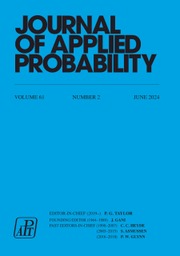No CrossRef data available.
Article contents
An urn model arising from all-optical networks
Published online by Cambridge University Press: 14 July 2016
Abstract
An occupancy model that has arisen in the investigation of randomized distributed schedules in all-optical networks is considered. The model consists of B initially empty urns, and at stage j of the process d j ≤ B balls are placed in distinct urns with uniform probability. Let M i (j) denote the number of urns containing i balls at the end of stage j. An explicit expression for the joint factorial moments of M 0(j) and M 1(j) is obtained. A multivariate generating function for the joint factorial moments of M i (j), 0 ≤ i ≤ I, is derived (where I is a positive integer). Finally, the case in which the d j , j ≥ 1, are independent, identically distributed random variables is investigated.
MSC classification
Information
- Type
- Research Papers
- Information
- Copyright
- © Applied Probability Trust 2006

